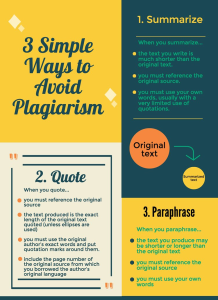8 Citation & Bibliography
In this chapter, we will practice:
- incorporating in-text citations in MLA, APA, and Chicago Manual Style
- creating bibliographies in MLA, APA, and Chicago Manual Style
- avoiding plagiarism and giving our sources credit
AVOIDING PLAGIARISM
Plagiarism is using someone else’s words and ideas as one’s own without giving credit or attribution to the source. When you get right down to it, plagiarism is theft. In some cases, a writer may plagiarize intentionally, while at other times, it may happen unintentionally. Here are some examples of how plagiarism can occur:
Plagiarism can be intentional:
- You use someone’s ideas or results without citing the source;
- You copy something word for word without using quotation marks, even though you cite the source;
- You use all or part of a visual without crediting the source; or
- You create a text entirely through the use of AI
Or it can be accidental:
- You don’t realize what is considered plagiarism in the United States;
- You can’t think of a better way to say it and so copy sentences, phrases, or even sentence structure from the original without using quotation marks;
- When you took notes, you didn’t put exact wording in quotation marks and now you plagiarize without realizing it.
- You might have engaged unknowingly in patchwriting.
It will always be necessary to use multiple sources in your writing, and with proper attribution, you won’t have to worry about plagiarism. Let’s look at some of the ways you can avoid plagiarism while still using your excellent source material.
Detailed Note-taking
During the information gathering phase of your writing, keep extremely detailed notes. Include citations for every source you use as you take notes, including the page number. And always remember, if you write something word-for-word from a source, always put this information in quotation marks.
Care-full Reading & Paraphrasing
Paraphrasing, which is putting source material into your own words, is a great way to incorporate information in your work. But, you must do this carefully and thoughtfully. Instead of taking the words of another writer, rearranging them and changing a few words, take the time to really understand what you’re reading. Find the information you need, read it slowly, then close your source, write the idea you’re reading about in your own words, and include a citation. This not only helps you avoid plagiarism, it also helps you learn and cognitively process new data into knowledge. Although you may no longer need to use quotation marks around your statement, it does not mean you no longer need to cite the source. When in doubt, cite your source. Don’t ever worry about using too many citations.

Image Credit: “How to Defend Against Online Plagiarism” by harrisxiong is licensed with CC BY 2.0.
Attributions
“How to Annotate,” Lumen Learning, CC BY-NC: Attribution-NonCommercial, https://courses.lumenlearning.com/engcomp1-wmopen/chapter/text-how-to-annotate/.
“How to Annotate Text,” Biology Corner, CC BY-NC, https://biologycorner.com/worksheets/annotate.html.
“How to Summarize—An Overview,” authored, remixed, and/or curated by Steven D. Krause, CC BY-NC-SA, https://human.libretexts.org/@go/page/6482.
“How to Quote and Paraphrase- An Overview,” authored, remixed, and/or curated by Steven D. Krause, CC BY-NC-SA, https://human.libretexts.org/@go/page/6483.
